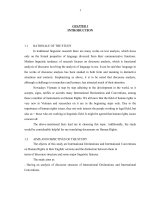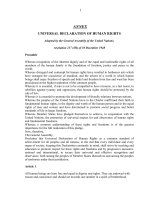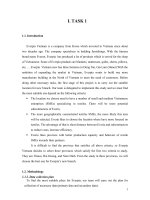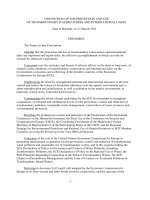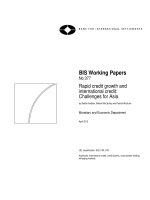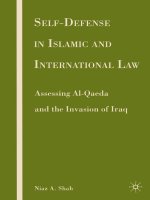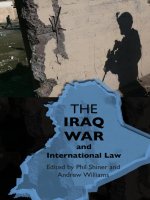USA and International Mathematical Olympiads2003
Bạn đang xem bản rút gọn của tài liệu. Xem và tải ngay bản đầy đủ của tài liệu tại đây (585.22 KB, 101 trang )
USA and International
Mathematical Olympiads
2003
c
° 2004 by
The Mathematical Association of America (Incorporated)
Library of Congress Catalog Card Number 2004?????
ISBN 0-88385-???-?
Printed in the United States of America
Current Printing (last digit):
10987654321
USA and International
Mathematical Olympiads
2003
Edited by
T itu Andreescu
and
Zuming Feng
Published and distributed by
The Mathematical Association of America
Council on Publications
Roger Nelsen, Chair
Roger Nelsen Editor
Irl Bivens Clayton Dodge
Richard Gibbs George Gilbert
Gerald Heuer Elgin Johnston
Kiran Kedlaya Lore n Larson
Marg aret Robinson Mark Saul
MAA PROBLEM BOOKS SERIES
Problem Books is a series of the Mathematical Association of America consisting
of collections of problems and solutions from annual mathematical competitions;
com pilations of problems (including unsolved problems) specific to particular
branches of mathematics; books on the art and practice of problem solving, etc.
A Friendly Mathematics Competition: 35 Years of Teamwork in Indiana, edited by
Rick Gillman
The Inquisitive Problem Solver, Paul Vaderlind, Richard K. Guy, and Loren C.
Larson
International Mathematical Olympiads 1986–1999, Marcin E. Kuczma
Mathematical Olympiads 1998–1999: Problems and Solutions From Around the
Wor l d , edited by Titu Andreescu and Zuming Feng
Mathematical Olympiads 1999–2000: Problems and Solutions From Around the
Wor l d , edited by Titu Andreescu and Zuming Feng
Mathematical Olympiads 2000–2001: Problems and Solutions From Around the
Wor l d , edited by Titu Andreescu, Zuming Feng, and George Lee, Jr.
The William Lowell Putnam Mathematical Competition P roblems and Solutions:
1938–1964, A. M. Gleason, R. E. Greenwood, L. M. Kelly
The William Lowell Putnam Mathematical Competition P roblems and Solutions:
1965–1984, Gerald L . Alexanderson, Leonard F. Klosinski, and Loren C. Larson
The William Lowell Putnam Mathematical Competition 1985–2000: Problems,
Solutions, and Commentary, KiranS.Kedlaya,BjornPoonen,RaviVakil
USA and International Mathematical Olympiads 2000, edited by Titu Andre escu
and Zuming Feng
USA and International Mathematical Olympiads 2001, edited by Titu Andre escu
and Zuming Feng
USA and International Mathematical Olympiads 2002, edited by Titu Andre escu
and Zuming Feng
USA and International Mathematical Olympiads 2003, edited by Titu Andre escu
and Zuming Feng
MAA Service Center
P . O. Box 91112
Washington, DC 20090-1112
1-800-331-1622 fax: 1-301-206-9789
www.maa.org
Preface ix
Acknowledgments xi
Abbreviations and Notations xiii
Introduction xv
1TheProblems 1
1 USAMO 1
2 TeamSelectionTest 3
3 IMO 5
2Hints 7
1 USAMO 7
2 TeamSelectionTest 8
3 IMO 9
3 Formal Solutions 11
1 USAMO 11
2 TeamSelectionTest 32
3 IMO 46
4ProblemCredits 61
5 Glossary 63
6FurtherReading 69
vii
viii
USA and International Mathematical Olympiads 2003
7 Appendix 75
1 2002 Olympiad Results 75
2 2002 Olympiad Results 77
3 2001 Olympiad Results 79
4 2000 Olympiad Results 80
5 1999 Olympiad Results 82
6 1999–2003 Cumulative IMO Results 83
About the Authors 85
Preface
This book is intended to help students preparing to participate in the USA
Mathematical Olympiad (USAMO) in the hope of representing the United
States at the International Mathematical Olympiad (IMO). The USAMO
is the third stage of the selection process leading to participation in the
IMO. The preceding examinations are the AMC 10 or the AMC 12 (which
replaced the American High School Mathematics Examination) and the
American Invitational Mathematics Examination (AIME). Participation in
the AIME and the USAMO is by invitation only, based on performance in
the preceding exams of the sequence.
The top 12 USAMO students are invited to attend the Mathematical
Olym piad Summer Program (MOSP) regardless of their grade in school.
Additional MOSP invitations are extended to the most promising non-
graduating USAMO students, as potential IMO participants in future years.
During the first days of MOSP, IMO-type exams are given to the top 12
USAMO students with the goal of identifying the six members of the USA
IMO Team. The Team Selection Test (TST) simulates an actual IMO,
consisting of six problems to be s olved over two 4 1/2 hour sessions. The
12 equally weighted problems (six on the USAMO and six on the TST)
determine the USA Team.
The Mathematical Olympiad booklets have been published since 1976.
Copies for each year through 1999 can be ordered from the Mathematical
Association of American (MAA) American Mathematics Competitions
(AMC). This publication, Mathematical Olympiads 2000, Mathematical
Olympiads 2001, and Mathematical Olympiads 2002 are published by the
MAA. In addition, various other publications are useful in preparing for the
AMC-AIME-USAMO-IMO sequence (see Chapter 6, Further Reading).
ix
x
USA and International Mathematical Olympiads 2003
For more information about the AMC e xaminations, or to order Mathe-
matical Olympiad booklets from previous years, please write to
Steven Dunbar, MAA Director for K–12 Programs
American Mathematics Competitions
University of Nebraska-Lincoln
1740 Vine Street
Lincoln, NE 68588-0658,
or visit the AMC web site at www.unl.edu/amc.
Acknowledgments
Thanks to Reid Barton, Gregory Galperin, Razvan Gelca, Gerald Heuer,
KiranKedlaya,BjornPoonen,CecilRousseau,AlexSaltman,andZoran
Suni
´
k for contributing problems to this year’s USAMO packet. Special
thanks to Reid, Kiran, Bjorn, and Richard Stong for their additional
solutions and comments made in their review of the packet. Thanks to
Kiran and Richard for their further comments and solutions from grading
Problems 3 and 6 on the USAMO. Thanks to Charles Chen, Po-Ru Loh and
Tony Zhang who proofread this book. Thanks to Anders Kaseorg, Po-Ru,
Tiankai Liu, and Matthew Tang who presented insightful solutions. And,
also, thanks to Ian Le, Ricky Liu, and Melanie Wood who took the TST
in advance to test the quality of the exam.
xi
Abbreviations
IMO International Mathematical Olympiad
USAMO United States of America Mathematical Olympiad
MOSP Mathematical Olympiad Summer Program
Notation for Numerical Sets and Fields
Z the set of integers
Z
n
the set of integers modulo n
Notations for Sets, Logic, and Geometry
⇐⇒ if and only if
=⇒ implies
|A| the number of elements in set A
A ⊂ BAis a proper subset of B
A ⊆ BAis a subset of B
A \ BAwithout B (the complement of A with respect
to B)
A ∩ B the intersection of sets A and B
A ∪ B the union of sets A and B
a ∈ A the element a belongs to the set A
AB the length of segment AB
d
AB the arc AB
−−→
AB the vector AB
xiii
Olympiad-style exams consist of several challenging essay-type prob-
lems. Correct and complete solutions often require deep analysis and
careful argument. Olympiad questions can seem impenetrable to the novice,
yet most can be solved by using elementary high school mathematics,
cleverly applied.
Here is some advice for students who attempt the problems that follow:
• Take your time! Very few contestants can solve all of the given
problems within the time limit. Ignore the time limit if you wish.
• Try the “easier” questions first (problems 1 and 4 on each exam).
• Olympiad problems don’t “crack” immediately. Be patient. Try differ-
ent approaches. Experiment with simple cases. In some cases, working
backward from the desired result is helpful.
• If you get stumped, glance at the Hints section. Sometimes a problem
requires an unusual idea or an exotic technique that might be explained
in this section.
• Even if you can solve a problem, read the hints and solutions. They
may contain some ideas that did not occur in your solution, and may
discuss strategic and tactical approaches that can be used elsewhere.
• The formal solutions are models of elegant presentation that you should
emulate, but they often obscure the torturous process of investigation,
false starts, inspiration and attention to detail that led to them. When
you read the formal solutions, try to reconstruct the thinking that went
into them. A sk yourself “What were the key ideas?” “How can I apply
these ideas further?”
• Many of the problems are presented together with a collection of
remarkable solutions developed by the examination committees, con-
xv
xvi
USA and International Mathematical Olympiads 2003
testants, and experts, during or after the contests. For each problem
with multiple solutions, some common crucial results are presented
at the beginning of these solutions. You are encouraged to either try
to prove those results on your own or to independently complete the
solution to the problem based on these given results.
• Go back to the original problem later and see if you can solve it in a
different way.
• All terms in boldface are defined in the Glossary. Use the glossary
and the reading list to further your mathematical education.
• Meaningful problem solving takes practice. Don’t get discouraged if
you have trouble at first. For additional practice, use prior years’ exams
or the books on the reading list.
1
The Problems
1USAMO
32nd United States of America Mathematical Olympiad
Day I 12:30
PM –5PM EDT
April 29, 2003
1. Prove that for every positive integer n there exists an n-digit numbe r
divisible by 5
n
all of whose digits are odd.
2. A convex polygon P in the plane is dissected into smaller convex
polygons by drawing all of its diagonals. The lengths of all sides and
all diagonals of the polygon P are rational numbers. Prove that the
lengths of all sides of all polygons in the dissection are also rational
numbers.
3. Let n 6=0. For every sequence of integers
a = a
0
,a
1
,a
2
, ,a
n
satisfying 0 ≤ a
i
≤ i,fori =0, ,n, define another sequence
t(a)=t(a)
0
,t(a)
1
,t(a)
2
, ,t(a)
n
by setting t(a)
i
to be the number of terms in the sequence a that
precede the term a
i
and are different from a
i
. Show that, starting
from any sequence a as above, fewer than n applications of the
transformation t lead to a sequence b such that t(b)=b.
1
2
USA and International Mathematical Olympiads 2003
32nd United States of America Mathematical Olympiad
Day II 12:30
PM –5:00PM EDT
April 30, 2003
4. Let ABC be a triangle. A circle passing through A and B intersects
segments AC and BC at D and E, respectively. Rays BA and ED
intersect at F while lines BD and CF intersect at M.Provethat
MF = MC if and only if MB · MD = MC
2
.
5. Let a, b, c be positive real numbers. Prove that
(2a + b + c)
2
2a
2
+(b + c)
2
+
(2b + c + a)
2
2b
2
+(c + a)
2
+
(2c + a + b)
2
2c
2
+(a + b)
2
≤ 8.
6. At the vertices of a regular hexagon are written six nonnegative
integers whose sum is 2003. Bert is allowed to make moves of the
following form: he may pick a vertex and replace the number written
there by the absolute value of the difference between the numbers
written at the two neighboring vertices. Prove that Bert can make a
sequence of moves, after which the number 0 appears at all six vertices.
The Problems
3
2 Team Selection Test
44th IMO Team Selection Test
Lincoln, Nebraska
Day I 1:00
PM –5:30PM
June 20, 2003
1. For a pair of integers a and b,with0 <a<b<1000,theset
S ⊆ {1, 2, ,2003} is called a skipping set for (a, b) if for any
pair of elements s
1
,s
2
∈ S, |s
1
− s
2
| 6∈ {a, b}.Letf(a, b) be the
maximum size of a skipping set for (a, b). Determine the maximum
and minimum values of f.
2. Let ABC be a triangle and let P be a point in its interior. Lines
PA, PB,andPC intersect sides BC, CA,andAB at D, E,andF ,
respectively. Prove that
[PAF]+[PBD]+[PCE]=
1
2
[ABC]
if and only if P lies on at least one of the medians of triangle ABC.
(Here [XY Z] denotes the area of triangle XY Z.)
3. Find all ordered triples of primes (p, q, r) such that
p | q
r
+1,q| r
p
+1,r| p
q
+1.
4
USA and International Mathematical Olympiads 2003
44th IMO Team Selection Test
Lincoln, Nebraska
Day II 8:30
AM –1:00PM
June 21, 2003
4. Let N denote the set of positive integers. Find all functions f : N → N
such that
f(m + n)f (m − n)=f(m
2
)
for all m, n ∈ N.
5. Let a, b, c be real numbers in the interval (0,
π
2
).Provethat
sin a sin(a −b) sin(a − c)
sin(b + c)
+
sin b sin(b − c)sin(b − a)
sin(c + a)
+
sin c sin(c − a) sin(c −b)
sin(a + b)
≥ 0.
6. Let
AH
1
, BH
2
,and
CH
3
be the altitudes of an acute scalene triangle
ABC. The incircle of triangle ABC is tangent to
BC, CA, and AB
at T
1
,T
2
, and T
3
, respectively. F or k =1, 2, 3,letP
i
be the point on
line H
i
H
i+1
(where H
4
= H
1
) such that H
i
T
i
P
i
is an acute isosceles
triangle with H
i
T
i
= H
i
P
i
. Prove that the circumcircles of triangles
T
1
P
1
T
2
, T
2
P
2
T
3
, T
3
P
3
T
1
pass through a common point.
The Problems
5
3IMO
44th International Mathematical Olympiad
Tokyo, Japan
Day I 9
AM –1:30PM
July 13, 2003
1. Let A be a 101-element subset of the set S = {1, 2, ,1000000}.
Prove that t here exist numbers t
1
,t
2
, ,t
100
in S such that the sets
A
j
= {x + t
j
| x ∈ A} j =1, 2, ,100
are pairwise disjoint.
2. Determine all pairs of positive integers (a, b) such that
a
2
2ab
2
− b
3
+1
is a positive integer.
3. A convex hexagon is given in which any two opposite sides have
the following property: the distance between their midpoints is
√
3/2
times the sum of their lengths. Prove that all the angles of the hexagon
are equal.
(A convex ABCDEF has three pairs of opposite sides: AB and
DE , BC and EF, CD and FA.)
6
USA and International Mathematical Olympiads 2003
44th International Mathematical Olympiad
Tokyo, Japan
Day II 9
AM –1:30PM
July 14, 2003
4. Let ABCD be a convex quadrilateral. Let P, Q and R b e the feet of
perpendiculars from D to lines BC,C A and AB, respectively. Show
that PQ = QR if and only if the bisectors of angles ABC and ADC
meet on segment AC.
5. Let n be a positive integer and x
1
,x
2
, ,x
n
be real numbers with
x
1
≤ x
2
≤ ···≤ x
n
.
(a) Prove that
n
X
i=1
n
X
j=1
|x
i
− x
j
|
2
≤
2(n
2
− 1)
3
n
X
i=1
n
X
j=1
(x
i
− x
j
)
2
.
(b) Show that the equality holds if and only if x
1
,x
2
, ,x
n
form
an arithmetic sequence.
6. Let p be a prime number. Prove that there exists a prime number q
such that for every integer n, the number n
p
−p is not divisible by q.
2
Hints
1USAMO
1. Try small cases, and build up this number one digit a time. This
number is unique. We did not ask for the uniqueness in the statement
in order to not hint to the approach in the Third Solution.
2. Reduce the problem to a quadrilateral with lots of angles with rational
cosine values.
3. If the value of a term stays the same for one step, it becomes stable.
4. Let XY Z be a triangle with M the midpoint of side YZ.PointP
lies on segment XM.LinesYP and XZ meet at Q, ZP and XY at
R.ThenRQ k YZ.
5. It suffices to prove the desired result by assuming, additionally, that
a + b + c =3.
6. Controlling the maximum of the six numbers is not enough.
7
8
USA and International Mathematical Olympiads 2003
2 Team Selection Test
1. The extremes can be obtained by different approaches. One requires
the greedy algorithm, another applies congruence theory.
2. Apply the ingredients that prove Ceva’s Theorem to convert this into
an algebra problem.
3. Prove that one of the primes is 2.
4. Play with the given relation and compute many values of the function.
5. Reduce this to Schur’s Inequality.
6. The common point is the orthocenter of triangle T
1
T
2
T
3
.
Hints
9
3IMO
1. The greedy algorithm works!
2. Assume that a
2
/(2ab
2
−b
3
+1) = k,or,a
2
=2ab
2
k −b
3
k +k,where
k is a positive integer. Consider the quadratic equation x
2
−2b
2
kx +
(b
3
− 1)k =0for fixed positive integers b and k.
3. View the given conditions as equality cases of some geometric in-
equalities and consider the angles formed by three major diagonals.
4. Apply the Extended Law of Sines.
5. This is a clear-cut application of Cauchy–Schwarz Inequality.
6. The prime q is a divisor of p
p
− 1.

